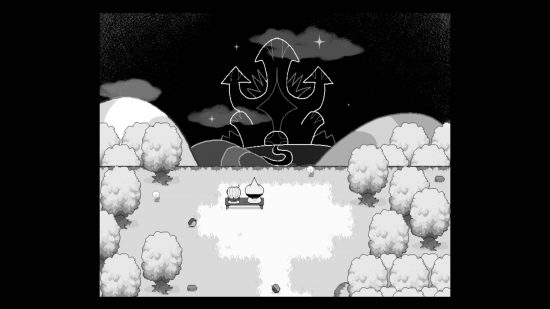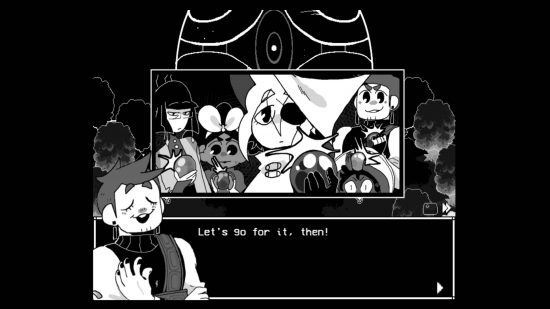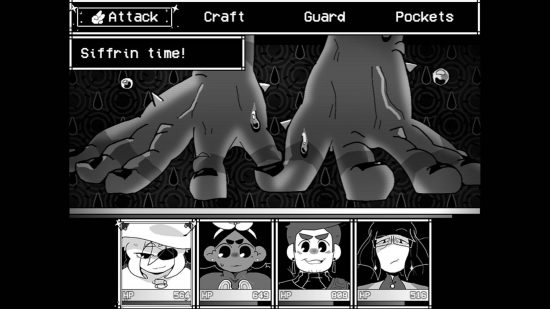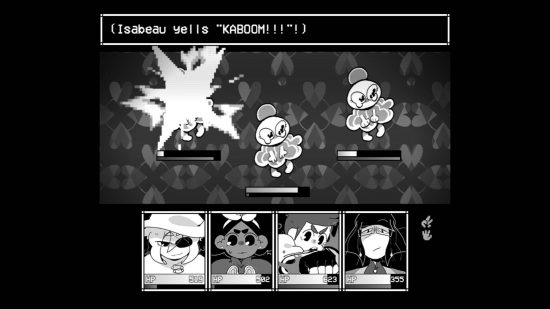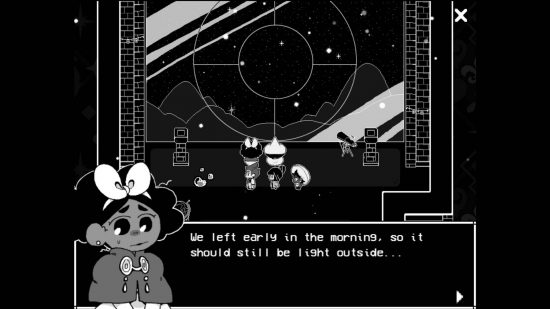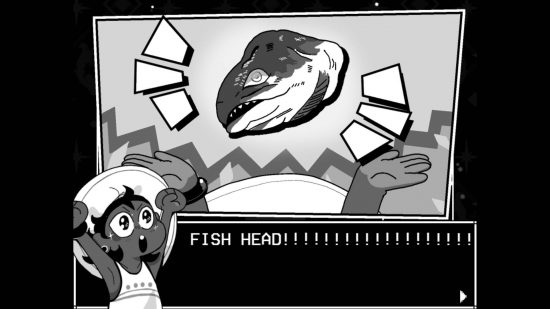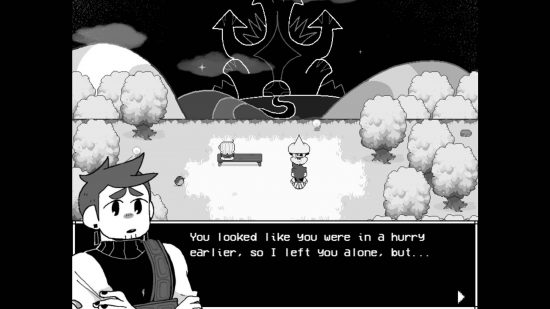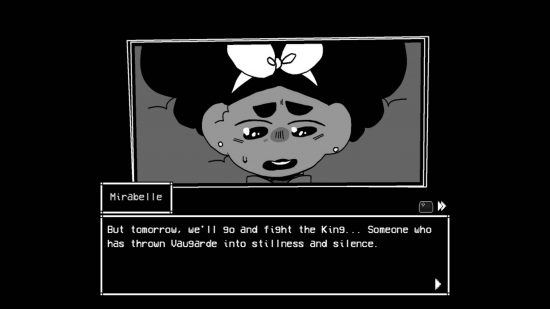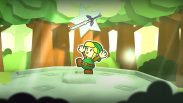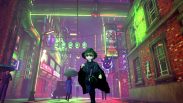It can take a lot for an indie game to stand out nowadays, especially in a post-Undertale world where there’s a deluge of 2D RPGs aping on the Earthbound aesthetics and lo-fi vibes. Luckily, In Stars and Time has a lot going for it with a striking monochrome style, character portraits filled with personality, and a unique time loop twist.
In Stars and Time is due to arrive on Nintendo Switch in early 2023, and ahead of this launch we spoke to developer Adrienne Bazir (she/they), also known as insertdisc5, the lone developer behind the title and its prequel (or perhaps prototype?) Start Again. A heartfelt story that explores what a time loop would feel like emotionally, and the idea of losing your friendships and connections repeatedly, In Stars and Time focuses on the power of found family and the connections you choose to make.
For anyone unfamiliar, In Stars and Stime is a time loop RPG about a character called Siffrin (he/they), who, on their way to beat an evil king, dies before they even reach the final dungeon. The next day, before they even know what’s going on, they wake alive and well, but now stuck in an eternal time loop forced to play the same day repeatedly.
While this seems like a miracle, Adrienne explains that this concept is darker than players might assume, saying, “It’d start as a blessing, because you can’t die, and you can just loop back whenever you want to fix your mistakes, but it’d quickly turn into a curse, wouldn’t it? I really wanted to dig deep into those emotions”.
The pixelated monochrome style brings to mind a lot of classic games, and that’s no accident, as Adrienne tells us. “I was very influenced by classic RPGs I played in my youth, like Tales of Symphonia. It’s a deconstruction of a fantasy, “the chosen one will save us all” RPG story, with lovable characters!”
The actual concept of the time loop opens up a lot of creative questions and the opportunity for some fairly meta answers. As Adrienne explains in terms of influences, “The Stanley Parable is another one, with its kinda-sorta time loop, and it is fascinating in how it sometimes says a one-off line that makes you question the whole premise of the game.”
Of course, inspiration is only one thing, and In Stars and Time looks to be entirely its own beast. Taking those themes and elevating them into something else is tough, so we asked what drove Adrienne to create the game and its focus on time loops, and the answer was simply “fanfiction! I love reading fanfics about a video game main character doing a New Game Plus, and looping back to the beginning of their story, with knowledge of what’s to come. I loved the concept so much I made a few original comics about it and then decided to make it a whole game!”
The energy and endearing spirit of this inspiration are clear and also bleed directly over from Adrienne’s surprisingly emotional comics. It’s a throughline that can also be tied directly back to the prototype of In Stars and Time, known as Start Again short proof of concept that ballooned from a small project into a fully-fledged two-three hour game. Adrienne explains that Start Again was made to test their skills and grow, as she explains saying “I quickly realized I couldn’t make In Stars and Time as I was then – I didn’t even know how to use RPGMaker, the software used to make the game”.
Alongside the emotional impact, one of the most clear pulls from Adrienne’s comics is the stark black and white visual style, which they explain is “partly because it saves time, and partly because I really like the way it looks”. But the other side of that is the challenge of making something stand out with a limited palette, which Adrienne relishes, asking “how [do you] make visuals and UI stand out if you only have black and white and grey at your disposal?”
This commitment to the monochrome style works wonders though, helping to make the world and characters jump out thanks to their powerful design and strong expressions. Adrienne’s work as a cartoonist was essential to bringing these characters to life, and something they enjoyed, saying, “I have to show off the characters’ expressions as best I can! I cannot only give them 10 portraits each! I have to show each character’s wide range of emotions!” It works, as it’s clear from gameplay footage that each character is drawn with love and care, ready for players to fall in love with them every single day.
Of course, time loops in games are nothing new, and to attempt one now is a challenge in and of itself. How do you separate yourself, and just what sort of time loop story are you trying to tell? Bazir explains that they wanted to examine the time loop in games in a different way, saying, “I find that games about time loops often use the time loops predominantly as a gameplay mechanic or a goal to figure out (“You’re in a time loop, that’s why you have endless retries!”, “You’re stuck in a time loop, but why?”), and don’t often go deep into what being stuck in one would mean, emotionally”.
Instead, In Stars and Time is looking to examine just what a time loop would do to a character, and how that would change their actions going forward. The trauma of experiencing things over and over again is something that not enough games explore, though Adrienne does explain that games like Higurashi, I Was a Teenage Exocolonist, and Zero Escape have their own versions of these themes.
But for this game, Adrienne says “I wanted to make sure that every event would noticeably affect Siffrin, and affect the story, so, for example, dying too often, in the same way, will make Siffrin react to some things differently. And almost all events you can see will vary slightly, depending on if it’s the first time, second time, or tenth time you’ve seen it!”
You won’t lose everything though, as Saffrin can carry experience and levels from one time loop to the next, but they are the only one who remembers anything about the loops. Other party members have no idea and will lose their experience on every new day, but you can mitigate this by using save points to save their levels and unlocked skills. Adrienne explains that there is even more to your team members as well, as players can “also equip memories of them, which can give them back certain skills, or learn others!”
Outside of time loops, In Stars and Time is at its core a story about found family, and that can’t be separated from it’s LGBTQ characters and themes. The idea of losing people – and their memories – and having to start again is something that will be familiar to many people who have been stigmatised for who they are. Instead, Bazir wants this world to be a place where there isn’t such a stigma and people are open to being who they really are. But also, queerness isn’t a defining characteristic, it’s just a natural part of a greater whole.
Adrienne explains their approach by saying, “The main characters are all some flavour of queer, yes, but for most of them, that’s not a key part of how they’d define themselves, or how they relate to one another. I really wanted to explore what it would mean to be queer in this world so different from ours”.
Similarly, the concept of a found family fits perfectly with both queer themes and the RPG genre. As Bazir puts it, “having a group of characters travelling together, and ending up as “family”, is what quests and RPGs are all about! They travel together, find parts of themselves and each other, and at the end of their travels, end up forever changed.”
An RPG at its core, In Stars and Time features a battle system not dissimilar from the rock, paper, scissors mechanics that games like Pokémon have taken and expanded on. This was born out of problems Bazir faced when creating Start Again, as “one of the puzzles asks you to find a torch, to burn something that’s blocking everyone’s way. At the time, I was thinking of giving everyone basic Fire Water Earth powers, but then, I thought… “If they have fire powers in this world, why couldn’t they just burn what’s blocking their way?!”
Instead, this game adapts a different system that uses a type of magic called craft, which is based around creating things and moulding the world as you see fit, a nice touch in a world where characters are allowed to live their life with freedom to express themselves. It all fits into the world, as Adrienne explains that “the main challenge it created was that I had to find a way to make it make sense in this world, narratively speaking. Fire Water Earth makes sense, but Rock Paper Scissors is just weird!”
For Adrienne, In Stars and Time has also been a way for them to express some of their own thoughts about queerness and gender, saying, “that I came out as nonbinary when the prologue came out, and I have added some of my musings on gender on this game. Siffrin and Bonnie both use they/them pronouns, and being queer isn’t as important in the world of In Stars and Time as it is in ours.”
Everyone has their own story though, and In Stars and Time will tell a story that allows everyone to see something different depending on their own experience. As Bazir puts it, “I think it’s more interesting to let people derive their own meaning from my story. Maybe it’ll affect someone in ways I didn’t even intend, and that’s what’s fun about art!”
With a story and a style so intrinsically tied to a single person, it’s gratifying to see so much personality in a game, and someone being allowed to be creative in different ways. The title is also a way to share queer experiences, and that’s something Adrienne looks forward to putting out in the world. As they explain, “I hope it’ll make some people feel seen, and for the ones that don’t feel seen, I hope it’ll make them consider something new. Also: two asexual main characters!!! Let’s go aces!!!”
In a world where queerness is being attacked every day, it’s refreshing to see such an expression of identity in a video game, and to see these themes and stories being told so well. In Stars and Time looks like a great RPG at its core and a potential haven for queer players looking to explore a world that sees and understands them. It also looks really fun to play, something Adrienne backs up, explaining “I actually really love playing this game, which is not something I usually feel towards my own work. I usually just do a thing and then I forget I made it. But genuinely liking something I made is a new feeling”
The DNA of Adrienne Bazir is in every pixel of In Stars and Time, but it seems that the story being told is one for everyone to experience and make their own. The emotional weight of a time loop might be something a lot of people stuck inside can relate to anyway, but the open and loving depiction of queerness might just help some players who have had to fight for their own found family. Here’s hoping the world becomes a little more like In Stars and Time in the future, but for now all we can do is hope to wake up to a kinder day.
